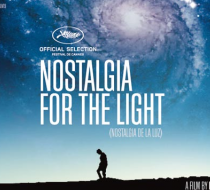Nostalgia for the Light 1 Favorite
The Atacama Desert in northern Chile — the setting of Patricio Guzmán’s transfixing cinematic essay “Nostalgia for the Light” — is a place where heaven and earth converge. Or some might say heaven and hell.
Situated on the leeward side of the Chilean Coast Range, more than 10,000 feet above sea level, it is one of the highest deserts and driest places on Earth. Viewed from space, it is a brown spot on the planet. No rainfall has ever been recorded in its driest parts, and without moisture, everything is preserved. Pre-Columbian drawings were inscribed in rock some 2,000 years ago.
The thin atmosphere and low humidity have made the desert a magnet for astronomers. Here their telescopes can gaze farther into the universe than from anywhere else in the world. The opening image is the interior of a radio telescope pointed to the stars, which are so bright and clear they seem to flare like miniature high-wattage light bulbs.
Because much of that incandescence emanates from thousands of light years away, the film emphasizes, astronomy is really a study of the past — eons of it — the better to discover who we are, where we came from and where we might be headed.
But the Atacama was also the site of a concentration camp created in the 1970s by the dictatorship of Gen. Augusto Pinochet from the workers’ barracks in the abandoned 19th-century salt-mining town Chacabuco. Thousands of political prisoners, many of whom later “disappeared,” were kept there. Today their surviving relatives, carrying shovels, go to dig for their remains, most of which were very likely dumped into the ocean.
For Mr. Guzmán, who is best known for his monumental documentary trilogy in the 1970s, “The Battle of Chile,” and for his sorrowful 2004 screen biography, “Salvador Allende,” the parallel searches for cosmic origins and for the disappeared people are interlocking metaphors for the human search for meaning and continuity. Astronomy and archaeology, he believes, are variations of the same quest, with one directed toward the sky and the other into the earth.
Mr. Guzmán’s quietly reflective narration (in subtitled Spanish) is a poetic meditation on time and distance. But it is also pointedly political in its focus on remembrance. On a personal level, “Nostalgia for the Light” is his “À la Recherche du Temps Perdu” in its expression of his longing for a time when Chile was “a haven of peace, isolated from the world,” a place where “only the moment existed.”
Defining the moment, however, is tricky. We meet Gaspar Galaz, a young astronomer who theorizes that the present doesn’t exist because of the time it takes for light to reach a viewer. The only example of cinematic overreaching is its juxtaposition of what looks like digital stardust — or is it a purposeful double exposure of the heavens and the earth? — on earthbound images.
We meet two women in their 70s, Victoria and Violeta, who have spent the better part of three decades combing the landscape for the remains of their loved ones. Victoria found a foot with her husband’s shoe on it, and she takes comfort from the discovery. We also meet Miguel, a survivor of five concentration camps, who from memory drew precise layouts of each prison after his release.
The film’s passionate insistence on remembrance lends it a moral as well as a metaphysical weight. Mr. Guzmán’s belief in eternal memory is an astounding leap of faith.
-
Stephen Holden, The New York Times







